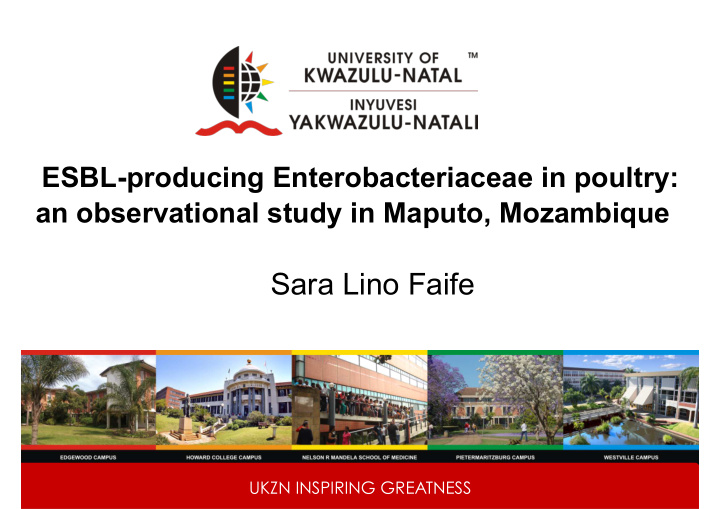



ESBL-producing Enterobacteriaceae in poultry: an observational study in Maputo, Mozambique Sara Lino Faife UKZN INSPIRING GREATNESS
1. Introduction • Antibiotic resistance is considered a global health problem for many decades (CDC, 2010) • One of the most studied and clinically relevant resistance mechanism in bacteria is extended-spectrum beta- lactamase (ESBL) - producing Enterobacteriaceae . • ESBL-producing bacteria are not isolated only in humans but also in food-borne bacteria (Plateel et al. 2013) UKZN INSPIRING GREATNESS
1. Introduction • Food animals, including chickens, turkeys, pigs and cattle, may be colonized by ESBL and/or plasmid-mediated AmpC ( pAmpC )-producing Escherichia coli (Carttoli, 2008). • The most frequent ESBL genes associated with this resistance among food producing animals and companion animals encode various CTX-M enzymes, followed by bla TEM-52 and bla SHV-12 (Ewers et al, 2011) • Chicken is one of the most consumed foods by the population in Mozambique. UKZN INSPIRING GREATNESS
1. Introduction Reseach question • Are there ESBL/ AmpC -producing Enterobacteriaceae in imported and locally produced chicken? UKZN INSPIRING GREATNESS
2. Objectives • Aim • To investigate the presence of the ESBL/ AmpC -producing Enterobacteriaceae in imported and locally produced chicken and perform relevant phenotypic and genotypic characterization of resistant isolates. • Objectives • Screen for ESBL-producing isolates by culturing samples from thaw liquid and carcass from poultry produced in Mozambique, South Africa and Brazil. UKZN INSPIRING GREATNESS
2. Objectives • To identify bacterial isolates from imported and domestically produced chickens/poultry to species level • To ascertain the antibiotic susceptibility of isolates against an appropriate panel of antibiotics by standardized agar disc diffusion and/or minimum inhibitory concentration (MIC) determination • To phenotypically confirm the production of: – ESBLs using the double-disc synergy test, – AmpC β -lactamase using the cefoxitin disc sensitivity test, and, UKZN INSPIRING GREATNESS
2. Objectives • To identify the EBSL and/or AmpC genes by PCR and sequencing • To ascertain similarities of isolates using ERIC PCR • To compare the phenotypic and genotypic differences between imported and domestically produced chickens/ poultry • To disseminate the information to policy-makers to improve/inform agricultural practice related to growth promoters in poultry UKZN INSPIRING GREATNESS
3. Methods • Ethical Considerations • Ethical clearance was received from Biomedical Research Ethics Committee of University of KwaZulu-Natal • Sampling • In the study were included 99 frozen chickens imported from South Africa (33) and Brazil (33), as well as chickens produced in Mozambique and they were acquired in 3 different supermarkets. UKZN INSPIRING GREATNESS
Sampling • In each chicken were obtained 2 samples from: • (1) thaw liquid and • (2) swab of the internal part of the carcass, totaling 198 samples from 99 chickens UKZN INSPIRING GREATNESS
Strains iden+fica+on • Four plates per sample of chicken were used (1) 2 MacConkey plates to prove growth of Enterobacteriaceae, and (2) 2 Macconkey with 2mg/l of ceftriaxone to select for ESBL-producers. • The 2 samples were from (1) thaw liquid and (2) swab of the internal part of the carcass. • Colonies were biochemically tested for bacteria identification. UKZN INSPIRING GREATNESS
Susceptibility test and phenotical evaluation antimicrobial susceptibility and resistance testing based on agar disc diffusion: • according to CLSI guidelines (2015) recommended panel of antibiotics. • phenotypical evaluation for the presence of ESBL/ pAmpC – disk sinergy test (CLSI, 2015). • ESBL confirmation - double-disc diffusion test following the ROSCO diagnostic (Kits for detection of resistance mechanism) ( EUCAST, 2013). • During all procedures will be guaranteed quality control of the Medias and discs. UKZN INSPIRING GREATNESS
DNA extraction, PCR and Electrophoresis • The DNA extraction was done using Gram-Negative Bacteria Gene JET Genomic DNA Purification Kit (Thermo Scientific, USA). • Clonality was done using Enterobacterial Repetitive Intergenic Concensus-PCR analysis UKZN INSPIRING GREATNESS
The PCR amplification and Sequence • The PCR was done using Phusion Flash High-Fidelity PCR Mater Mix (Thermo Scientific, USA) protocol and primers already described with different annealing temperatures • The amplicons obtained were visualized by electrophoresis • The sequences were analyzed using Basic Local Alignment Search Tool UKZN INSPIRING GREATNESS
4. Results Table 1: bacterias isolated by place of provenience Nr. Bacterias name Nr. Of positive Provenience samples 1 Enterobacter 1 Mozambique Cloacae 2 Enterobacter 1 South Africa aglomerans 3 Citrobacter divresus 1 South Africa 4 Citrobacter freundii 3 South Africa (2) Brazil (1) 5 Escherichia coli 21 South Africa (15) Mozambique (4) Brazil (2) UKZN INSPIRING GREATNESS
Table: 2-Number of samples with ESBL A , AmpC and Fluoroquinolone resistance Nr ESBL AmpC • Nr of samples 23 10 SHV-85% (CMY, FOX, MOX CTX-M-62% and DHA)-below TEM-44% 50% UKZN INSPIRING GREATNESS
rep-PCR_Sara rep-PCR_Sara 100 20 40 60 80 A25C A29C A17C A26D South Africa A26C A23C A27C A25D B18C A32D M27D M32C A30C B17C A33D B23D M27C A30D A13D A20C A12C M30C A10C A10D UKZN INSPIRING GREATNESS
Preliminary findings • South African chickens yieded the most bacteria • Complexity and diversity of resistance was evident • Sequence analysis and correlation of all results is pending UKZN INSPIRING GREATNESS
REFERENCES 1. Centers for Disease Control and Prevention (2010) Get smart: know when antibiotics work. Available from: www.cdc.gov/Features/GetSmart . Accessed: 18 May 2015. 2. Platteel TN, Leverstain-van Hall MA, Cohen Stuart JW, Voets GM, Van Den Munckhof MP, Scharringa J, Van de Sande N, Fluit AC, Bonten MJ and behalf of the ESBL Nation Surveillance Working Group (2013) Differences in antibiotic susceptibility of human Escherichia coli with poultry associated and non-poultry associated extended spectrum beta-lactamases. Eur. J. Clin. Microbiol. Infect. Dis. 32: 1091-1095. 3. Carattoli A (2008) Animal reservoirs for extended spectrum beta-lactamase producers . Clin Microbiol Infect 14 Suppl 1: 117–123. 4. Ewers C, Grobbel M, Bethe A, Wieer H, Guenther S (2011) Extended-spectrum β - lactamase-producing gram negative bacteria in companion animals: action is early warranted ! Berl Munch TierarztlWochenschr 124: 10-17. • UKZN INSPIRING GREATNESS
Acknowlegments • My Supervisors: Prof Sabiha Essak, Sundsfjord Tomas and • UKZN stuff-John Osei Sekyere • ISCISA • NORAD Project UKZN INSPIRING GREATNESS
• Obrigada UKZN INSPIRING GREATNESS
Recommend
More recommend